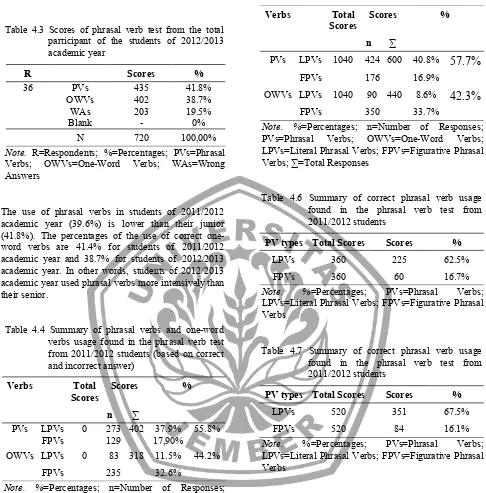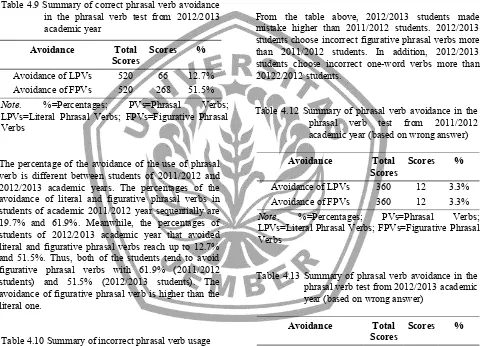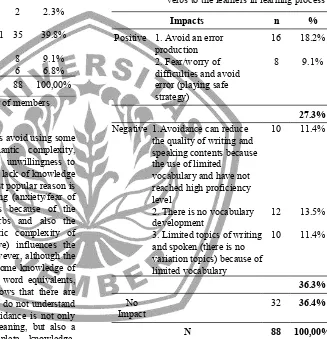Introduction
As a part of learning strategy, avoidance is one of the strategies that is usually used by learners to avoid error production and to overcome difficulties in the learning process. Furthermore, avoidance is used as
strategy to avoid an error production in foreign or second language (Mattar, 2003:103). Avoidance is viewed as a strategy that is used by EFL learners to overcome their difficulties from difficult item or structure in the target language (L2). In the English learning process, one of the subjects learned by the learners is phrasal verbs. Phrasal verb is a part of
Abstract
This study endeavors to investigate the avoidance of phrasal verbs as a strategy in learning process. This study aims to find out the effect of semantic nature of different types of phrasal verb (literal and figurative) in the learners’ tendency to avoid phrasal verb, to describe how the impact(s) of the avoidance strategy to the learners in learning process and what are the reasons. The subject of this research is English Department students in Jember University that takes 36 students from 2011/2012 academic year and 52 students from 2012/2013 academic year. To accomplish this, the test and questionnaires are administrated. The result of the study shows that both 2011/2012 and 2012/2013 students tend to use phrasal verbs more than one-word verb. The avoidance of phrasal verbs of both academic years is weak compared to one-word verbs avoidance. Moreover, based on the test result showing the uses of phrasal verbs, the students tend to avoid figurative phrasal verbs dominantly more than literal phrasal verbs. Furthermore, the students dominantly choose one-word verbs because of their being uncertain about the meaning (lack of knowledge). The avoidance strategy itself appears to give negative impact for the learners in the learning process. Avoidance causes the vocabulary to be limited and undeveloped..
Keywords: Learning Strategy, Avoidance, Phrasal Verb, Figurative Phrasal Verb, Literal Phrasal Verb.
Abstrak
Penelitian ini bertujuan untuk mengetahui tentang penghindaran phrasal verb sebagai strategy dalam pembelajaran. Penelitian ini bertujuan untuk menemukan efek dari dua tipe phrasal verb yang berbeda secara makna (literal and figurative phrasal verbs) dalam kecenderungan pembelajar dalam menghindari phrasal verb, unruk mendiskripsikan bagaimana efek dari penghindaran phrasal verb serta apa saja alasan mereka menghindarinya. Subjek dalam penelitian ini adalah mahasiswa Sastra Inggris, Fakultas Sastra, Universitas Jember sebanyak 36 dari angkatan tahun 2011/2012 dan 52 dari 2012/2013. Untuk mengetahui hasilnya, penelitian ini menggunakan tes dan kuisoner. Hasil dari peneliian menunjukkan bahwa mahasiswa angkatan 2011/2012 dan 2 012/2013 cenderung menggunakan phrasal verbs lebih banyak daripada one-word verbs. Tingkat penhindaran phrasal verbs kedua angkatan cenderun lemah dibandingka dengan penghindaran one-word verbs. Berdasarkan pengunaan phrasal verbs, mahasiswa secara dominan cendeung menghindari figurative phrasal verbs daripada literal phrasal verbs. Mahasiswa cenderung menggunakan one-word verbs karena mereka tidak yakin akan arti dari phrasal verbs (kurangnya pengetahuan akan phrasal verbs). Strategy penghindaran sendiri memberi dampak negatif untuk mahasiswa di dalam proses pembelajaran. Penghindaran menyebabkan kosakat terbatas dan tidak berkembang.
Kata kunci: Strategi Pembelajaran, Penghindaran, Phrasal Verb, Figurative Phrasal Verb, Literal Phrasal Verb.
Christina Lusi Nur Farida, Samudji, Hari Supriono English Department, Faculty of Letters, Jember University
Jln. Kalimantan 37, Jember 68121 E-mail: [email protected]
Avoidance of the English Phrasal Verbs as a Strategy in Learning Process:
vocabularies that is designed to develop a set of ability in communication. Native speakers of English use full phrasal verb when they are writing and speaking (Sangoor, 2012:93). It shows that when the learners want to master English like the native speaker of English, the students have to apply more phrasal verb in their communication. Further, phrasal verbs have been regarded as important component in learning. However, Indonesian learners that do not have phrasal verb structure in their language will find troubles in applying phrasal verbs in L2 production and tend to avoid. Avoidance of phrasal verbs belongs to lexical avoidance strategy. Lexical or vocabulary avoidance strategy occurs because there is a semantic difference between L1 and L2, L1-L2 structure differences and also L1 and L2 similarity.
In accordance with the phenomena it aimed to answer the following questions:
1. How frequent do the students avoid phrasal verb types related to the semantic complexity (literal and figurative phrasal verbs)?
2. Why do the learners do avoidance?
3. Does their avoidance give impact on their learning process? If any, how does the avoidance impact the learners in learning process?
Literature Review
Avoidance strategy is used when the learners encounter difficulty in both spoken and written communication. The learners will choose to produce or avoid certain structure in the learning process (Gass & Selinker, 2008:138). Pazhakh (2006:2) states that when speaking or writing using second or foreign language, the learner often avoids some difficult words, structures, topics, etc. with easier words or structures. “Avoidance occurs when learners know or expect the existence of a problem and at least have some truncated idea of what the target form is like, avoidance arises when learners know what the target form is like but find it too difficult to be used and avoidance is apparent when learners know what to say and how to say it but are unwilling to express it since it yields to flout their norms of behavior” (Kellerman, 1992 in Sara and Mohammadreza, 2013:238). However, semantic complexity has a great role in avoidance (Laufer and Eliasson, 1993:46). Furthermore, Hulstijn and Marchena (1989) also say that EFL learners of English avoid phrasal verbs because the differences between transparent and nontransparent meaning of phrasal verbsalso give an influence. Li (1996:182) also states that semantic or structural aspects of target language features contributed to avoidance. The main theory of this research is avoidance of phrasal verbs but same naturewith literal and figurative phrasal verbs of Liao and Fukuya's.
Research Methodology
This research is conducted by using both qualitative and quantitative method. Quantitative method is applied because this study tries to describe the result of the test and questionnaire in the form of number and the percentage of the use of literal and figurative phrasal verbs. Therefore, qualitative method is also used to describe the result of the test, the reasons and the impact(s) of avoidance of phrasal verb in the learning process. In this research, I use double-ended questionnaires (open-ended and closed-ended questionnaire). There are two questionnaires. First questionnaire consists of seven questions that are distributed before the test. The questionnaire is used to complete the information about the personal perception about avoidance of phrasal verb and to know the reason and impact of the students doing avoidance in the learning process. Second questionnaire is distributed after the test. The second questionnaire is closed-questions which are related to the test. The
The result of the study shows that both 2011/2012 and 2012/2013 students tend to use phrasal verbs. academic years tend to avoid figurative phrasal verbs dominantly rather than literal phrasal verbs.
Table 4.3 Scores of phrasal verb test from the total
Note. R=Respondents; %=Percentages; PVs=Phrasal Verbs; OWVs=One-Word Verbs; WAs=Wrong academic year. In other words, students of 2012/2013 academic year used phrasal verbs more intensively than their senior.
Table 4.4 Summary of phrasal verbs and one-word verbs usage found in the phrasal verb test from 2011/2012 students (based on correct and incorrect answer) PVs=Phrasal Verbs; OWVs=One-Word Verbs; LPVs=Literal Phrasal Verbs; FPVs=Figurative Phrasal rather than figurative phrasal verbs. Then, they avoid figurative phrasal verb higher than literal phrasal verbs (see table 4.4 and 4.5).
Table 4.5 Summary of phrasal verbs and one-word verbs usage found in the phrasal verb test from 2012/2013 students (based on correct and incorrect answer)
Verbs Total
Scores
Scores %
n ∑
PVs LPVs 1040 424 600 40.8%
57.7%
FPVs 176 16.9%
OWVs LPVs 1040 90 440 8.6%
42.3%
FPVs 350 33.7%
Note. %=Percentages; n=Number of Responses; PVs=Phrasal Verbs; OWVs=One-Word Verbs; LPVs=Literal Phrasal Verbs; FPVs=Figurative Phrasal Verbs; ∑=Total Responses
Table 4.6 Summary of correct phrasal verb usage found in the phrasal verb test from 2011/2012 students
PV types Total Scores Scores %
LPVs 360 225 62.5%
FPVs 360 60 16.7%
Note. %=Percentages; PVs=Phrasal Verbs; LPVs=Literal Phrasal Verbs; FPVs=Figurative Phrasal Verbs
Table 4.7 Summary of correct phrasal verb usage found in the phrasal verb test from 2011/2012 students
PV types Total Scores Scores %
LPVs 520 351 67.5%
FPVs 520 84 16.1%
Note. %=Percentages; PVs=Phrasal Verbs; LPVs=Literal Phrasal Verbs; FPVs=Figurative Phrasal Verbs
Table 4.8 Summary of correct phrasal verb avoidance in the phrasal verb test from 2011/2012 academic year
Avoidance Total
Scores
Scores %
Avoidance of LPVs 360 71 19.7% Avoidance of FPVs 360 223 61.9% Note. %=Percentages; PVs=Phrasal Verbs; LPVs=Literal Phrasal Verbs; FPVs=Figurative Phrasal Verbs
Table 4.9 Summary of correct phrasal verb avoidance in the phrasal verb test from 2012/2013 academic year
Avoidance Total
Scores
Scores %
Avoidance of LPVs 520 66 12.7% Avoidance of FPVs 520 268 51.5% Note. %=Percentages; PVs=Phrasal Verbs; LPVs=Literal Phrasal Verbs; FPVs=Figurative Phrasal Verbs
The percentage of the avoidance of the use of phrasal verb is different between students of 2011/2012 and 2012/2013 academic years. The percentages of the avoidance of literal and figurative phrasal verbs in students of academic 2011/2012 year sequentially are 19.7% and 61.9%. Meanwhile, the percentages of students of 2012/2013 academic year that avoided literal and figurative phrasal verbs reach up to 12.7% and 51.5%. Thus, both of the students tend to avoid figurative phrasal verbs with 61.9% (2011/2012 students) and 51.5% (2012/2013 students). The avoidance of figurative phrasal verb is higher than the literal one.
Table 4.10 Summary of incorrect phrasal verb usage found in the phrasal verb test from 2011/2012 students
Verb types
Total Scores Scores %
LPVs 360 48 13.3%
FPVs 360 69 19.2%
Note. %=Percentages; PVs=Phrasal Verbs; LPVs=Literal Phrasal Verbs; FPVs=Figurative Phrasal Verbs
Table 4.11 Summary of incorrect phrasal verb usage found in the phrasal verb test from 2012/2013 students
Verb types
Total Scores Scores %
LPVs 520 73 14,00%
FPVs 520 92 17.7%
Note. %=Percentages; PVs=Phrasal Verbs; LPVs=Literal Phrasal Verbs; FPVs=Figurative Phrasal Verbs
From the table above, 2012/2013 students made mistake higher than 2011/2012 students. 2012/2013 students choose incorrect figurative phrasal verbs more than 2011/2012 students. In addition, 2012/2013 students choose incorrect one-word verbs more than 20122/2012 students.
Table 4.12 Summary of phrasal verb avoidance in the phrasal verb test from 2011/2012 academic year (based on wrong answer)
Avoidance Total
Scores
Scores %
Avoidance of LPVs 360 12 3.3% Avoidance of FPVs 360 12 3.3% Note. %=Percentages; PVs=Phrasal Verbs; LPVs=Literal Phrasal Verbs; FPVs=Figurative Phrasal Verbs
Table 4.13 Summary of phrasal verb avoidance in the phrasal verb test from 2012/2013 academic year (based on wrong answer)
Avoidance Total
Scores
Scores %
Avoidance of LPVs 520 40 7.6% Avoidance of FPvs 520 66 12.7% Note. %=Percentages; PVs=Phrasal Verbs; LPVs=Literal Phrasal Verbs; FPVs=Figurative Phrasal Verbs
verbs about 7.6% (literal phrasal verbs) and 12.7% (figurative phrasal verbs).
Table 4.14 The reasons of the students avoiding phrasal verbs
Reasons n %
1. The meaning is too different from 2. Bahasa Indonesia (semantic complexity)
3. Complex structure
4.They have never known the terms before (never learned)
5.They know and understand it but unwilling to use
6. They are not sure about the phrasal verbs (anxiety/fear of difficulty)
Note. %=Percentages; n=the number of members
There are some reasons why students avoid using some phrasal verbs such as the semantic complexity, structure complexity, unfamiliarity, unwillingness to use, fear of difficulty, habit/unusual, lack of knowledge and missing understanding. The most popular reason is they are not sure about the meaning (anxiety/fear of difficulty). The second reason is because of the complex structure of phrasal verbs and also the semantic complexity. The semantic complexity of phrasal verb (literal and figurative) influences the learners in using phrasal verbs. However, although the students in the present study have some knowledge of the target phrasal verbs and single word equivalents, the results of the present study shows that there are some students who do not know and do not understand about some phrasal verbs. The avoidance is not only because of the difficulty of the meaning, but also a result of ignorance and incomplete knowledge. Furthermore, based on the interview in some students, clarifies that the avoidance happen because the participants develop the habit of using one-word verbs, lack of knowledge about phrasal verbs, forget, have known the phrasal verb but they do not understand and feel that vocabulary is not significant. Some are also influenced by their perspective toward the lecturers.
Moreover, this study finds that there are some other reasons that influence the phrasal verbs avoidance based on each questions. There is difference reason in avoidance depending on the phrasal verbs. All students choose different answer. Some of them choose correct answer and incorrect answer, choose phrasal verb (both correct and incorrect phrasal verbs)
and avoid phrasal verbs (both correct and incorrect one-word verbs). Each answer has different reasons. The students that choose one-word verbs dominantly are uncertain about the meaning. When the phrasal verbs belong to figurative phrasal verbs, most students avoid them because they do not understand the meaning and some of them even do not know the meaning. In addition, several students pick wrong phrasal verbs because they are also uncertain about the meaning.
Table 4.15 The impact of the avoidance of phrasal verbs to the learners in learning process
Impacts n %
Positive 1. Avoid an error production
the quality of writing and speaking contents because the use of limited
vocabulary and have not reached high proficiency level
2. There is no vocabulary development
3. Limited topics of writing and spoken (there is no variation topics) because of
Discussion
The L1-L2 semantic differences (Liao and Fukuya 2004; Laufer and Eliasson 1993; Hulstijn and Marchena, 1989) between Indonesian and English learners can be the reason for the avoidance of phrasal verbs. Although most students tend to use phrasal verbs more than one-word verbs, there are not very strong differences. In relation to the literal and figurative phrasal verbs, Indonesian learners tend to avoid figurative phrasal verbs dominantly because the semantic meaning of figurative phrasal verbs are very different from the usual meaning of the each parts. they are uncertain about the meaning then they fear of the difficulty. Thus, to overcome the difficulties of the meaning, they use avoidance as strategy (Mattar, 2003:103). Furthermore, avoidance strategies in phrasal verbs can give negative impact to the learners in their writing and speaking. This result is in line with Barekat and Baniasady (2014:348) and Sangoor (2012:93). They conclude that argues the use of phrasal verbs expressions is important in spoken in order rich the proficiency like a native speaker.
The study shows that the avoidance can be used as strategy to encounter error but it can reduce the writing and speaking proficiency. The avoidance can be reduced with reducing anxiety and fear of difficulty of phrasal verbs. When, the learners has high motivation and be an risk-taker, it can reduce avoidance. However, many students only focus on their good score in the class, but they do not think about their vocabulary development. This finding can be used to improve the references about avoidance of phrasal verbs to removes the habit of Indonesian learners in avoidance to have better achievement. Furthermore, this finding can be useful for other researches, learners and teachers in learning process.
Conclusion
According to the result, both 2011/2012 and 2012/2013 students tend use phrasal verbs more than one-word verbs (avoid one-word verbs more than phrasal verbs). The learners in both academic years have weak tendency to avoid phrasal verbs but the percentage between the avoidance of phrasal verbs and one-word verbs are not too different. However, based on the result of the use of phrasal verbs (related to the semantic complexity of phrasal verbs, literal and figurative phrasal verbs), both academic years have strong tendency to avoid figurative phrasal verbs. Next, The most popular reason why students avoid
using some phrasal verbs is they are not sure about the meaning (anxiety/fear of difficulty). In addition, lack of knowledge of the phrasal verbs becomes the other main the reasons of the students doing avoidance. Lastly, Next, phrasal verbs avoidance dominantly gives negative impact for the learners in the learning process. Avoidance cause the vocabulary to be limited and
My sincere gratitude goes to my first and second supervisors, Prof. Dr. Samudji, M.A. and Hari Supriono, S.S., MEIL. who have encouraged and given me a valuable assistance to finish this thesis. Thank to Dr. Hairus Salikin, M.Ed, the Dean of Faculty of Letters and also Dra. Supiastutik, M.Pd, the Head of English Department for giving a chance to write this study. Thank you so much for all lecturers and also the librarians of the English Department, Faculty of Letters and the librarians of Central Library of Jember University.
References
Barekat, B. and Baniasady, B. 2014. “The Impact of Phrasal Verb Avoidance on the Writing Ability of the University EFL Learners.” International Conference on Current Trends in ELTProcedia - Social and Behavioral Sciences. Vol. 98: 343-352. Avoidance in L2 Learning: L2 Difference, L1-L2 Similarity, or L1-L2 Complexity?” Studies in Second Language. Vol. 15: 35-48.
Liao, Y.D. and Fukuyama, Y.J. 2004. “Avoidance of Phrasal Verbs: The case of Chinese Learners of English. Second Language Studies. Vol. 20: 71-106.
Mattar, H. 2003. “Is Avoidance ruled Out by Similarity? The Case of Subordination Conjunctions/Adverbs in English and Arabic.” Poznań Studies in Contemporary Linguistics. Vol. 38: 103-125.
Pazhakh, A. 2006. “An Investigation on Iranian EFL Learners’ Application of Avoidance Strategies in their Writings.” Iranian Journal of Language Studies. Vol. 1 (1): 1-12.
Sangoor, M. M. 2012. A syntactico-Semantic Study of English Phrasal Verbs. http://www.iasj.net/iasj? func=fulltext&aId=40836 [September, 2nd 2014].


